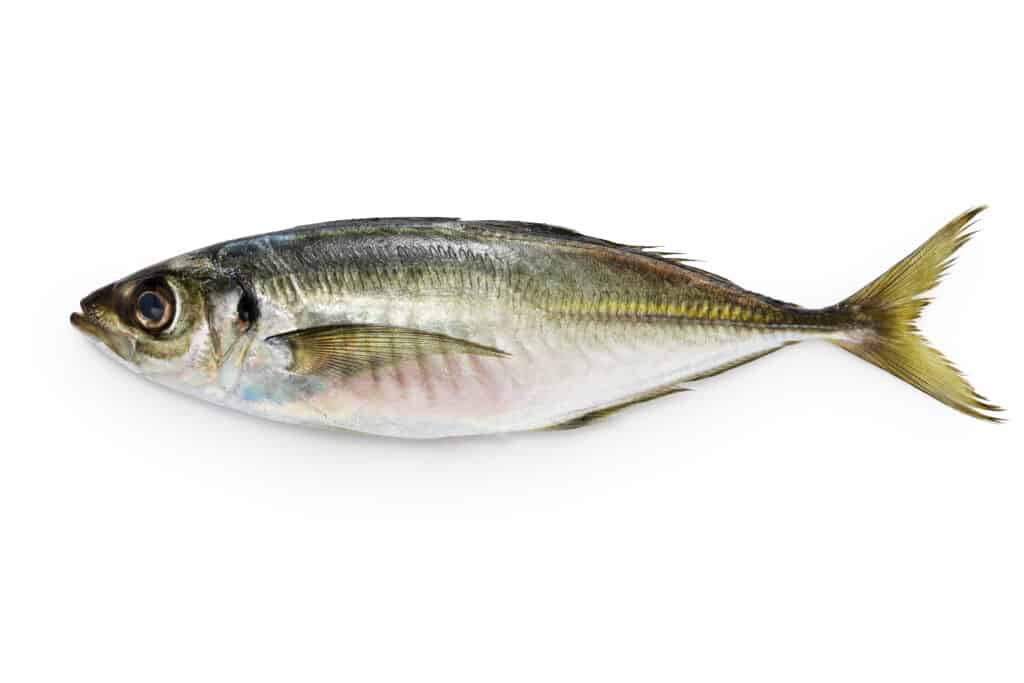Horse Mackerel
Trachurus Trachurus
Got their name from a myth that other fish would ride them over great distances
Advertisement
Horse Mackerel Scientific Classification
- Kingdom
- Animalia
- Phylum
- Chordata
- Class
- Actinopterygii
- Order
- Carangiformes
- Family
- Carangidae
- Genus
- Trachurus
- Scientific Name
- Trachurus Trachurus
Read our Complete Guide to Classification of Animals.
Horse Mackerel Conservation Status
Horse Mackerel Facts
- Prey
- Plankton, fish, crustaceans
- Group Behavior
- School
- Fun Fact
- Got their name from a myth that other fish would ride them over great distances
- Estimated Population Size
- Tens of billions
- Biggest Threat
- Overfishing
- Other Name(s)
- Common scad, jack mackerel
- Average Spawn Size
- 100,000+
- Habitat
- Pelagic waters
- Predators
- Whales, sharks, marlins, birds
- Diet
- Carnivore
- Lifestyle
- School
- Favorite Food
- Plankton
- Common Name
- Horse mackerel
- Migratory
- 1
View all of the Horse Mackerel images!
Summary
Horse mackerel refers to several different fish species found around the world. Most horse mackerels belong to the jack mackerel and scad family Carangidae. Among these is the Atlantic horse mackerel, or common scad, a popular species in the commercial fishing industry. These strong swimming, social fish thrive in warm and temperate waters and travel in giant schools containing tens of thousands of fish.
5 Horse Mackerel Facts
- The horse mackerel’s common name derives from a legend that other smaller fishes would ride on its back on long journeys.
- Horse mackerels are important to commercial fisheries thanks to their population density, nutrient content, and strong taste.
- Horse mackerels can live up to 40 years old in the wild.
- While they normally congregate in schools with other mackerel, horse mackerels will readily form schools with other fish for safety.
- Juvenile horse mackerels will hide in the tentacles of jellyfish to avoid predators.
Horse Mackerel Scientific name
Despite their name, few horse mackerel species belong to the “true” mackerel family, Scombridae. Instead, most horse mackerels are part of the family Carangidae. Common names for species vary depending on the region and include horse mackerels, jack mackerels, scads, and saurels. Within this family, most species belong to the genera Trachurus or Caranx. For example, the Atlantic horse mackerel’s scientific name is Trachurus trachurus. Its name derives from the Greek words trachys, meaning “rough,” and oura, or “tail,” in reference to the spiny plates located near its tail fin.
Meanwhile, the horse mackerel’s common name stems from a legend that other fish would ride on its back over great distances like a horse. It also has roots in the Dutch word horsmakreel, which translates to “a mackerel (makreel) that spawns in a shallow seaway (hors).
Horse Mackerel Appearance

While they normally congregate in schools with other mackerel, horse mackerels will readily form schools with other fish for safety.
©iStock.com/bonchan
The appearance of horse mackerel varies depending on the species. On average, they range between 10 and 24 inches long, as is the case with Atlantic horse mackerels. That said, some species can grow up to 50 inches long. Most horse mackerels appear quite slender and feature silver or grayish-blue scales. However, some species are quite colorful, such as the greenish-blue Japanese horse mackerel. Horse mackerels typically sport two dorsal fins and a long line of scutes that run from the head to the tail. These bony protrusions each feature a sharp spine that varies in size according to the species.
Horse Mackerel Behavior
Horse mackerels are social fish that live in large groups known as schools. They often congregate with other mackerels but will readily socialize with other fish, such as whiting. Horse mackerels are fast-moving fish that are almost always in motion. When feeding, they will often swim in large groups with their mouths open in the hopes of catching anything unfortunate enough to swim into their path. That said, they will sometimes break out into smaller groups, and larger specimens may even hunt alone. Like other fish, horse mackerels communicate with one other through motion or by sending out vibrations through the water.
Horse Mackerel Habitat
Generally speaking, horse mackerels live in either pelagic – open ocean – or shallow waters near the coasts. They prefer warm over cold water, and most species live throughout the Atlantic, Indian, and Pacific Oceans. That said, some particularly northern or southern populations live near the boundaries of the Arctic and Southern Oceans.
For instance, Atlantic horse mackerels spend most of their time at depths of around 330 to 600 feet, although they occasionally dive as deep as 3,440 feet. You can normally find eggs and juveniles in pelagic waters, while adults will travel back to shallower depths to breed and spawn.
Horse Mackerel Diet
The diet of horse mackerel varies depending on the species. That said, all horse mackerels are carnivores that tend to feed on smaller marine animals. Horse mackerels live in schools and hunt together as a unit. Moving together as one, they will swim with their mouths open and swallow anything that gets in their way. Juvenile horse mackerels tend to prey on plankton, mollusks, and crustacean larvae. As they grow older, their list of prey grows to include small fish such as sardines and herring, crustaceans, cephalopods, and jellyfish. Their sharp teeth enable them to rip apart crustacean shells with ease and bite through the scales of bony fish.
Horse Mackerel Predators and Threats
Several different species prey on horse mackerels in the wild. Orcas, sharks, and marlins are among the most significant predators of horse mackerel in the sea. Meanwhile, seagulls and other sea birds also prey on horse mackerels from the air. To avoid predators, juvenile Atlantic horse mackerels will often hide in the tentacles of jellyfish.
The other main threats that horse mackerels face come from humans in the form of commercial fishing and habitat loss due to pollution and climate change. Horse mackerels are a favorite target of commercial fisheries and are typically caught using trawls, purse seines, or longlines. These methods allow fishers to gather large quantities of fish at a time, and the schooling behavior of horse mackerels makes them easy targets. While most populations are relatively stable, a few – such as the Atlantic and Japanese horse mackerel – are in decline. Populations are further strained due to the effects of pollution and global warming, which can contaminate spawning and feeding grounds and make it more difficult for them to breed or find food.
Horse Mackerel Reproduction and Life Cycle
Like most fish, horse mackerel are oviparous animals, meaning that the females lay eggs. The reproductive cycle of a horse mackerel contains three phases: pre-reproductive, reproductive, and post-reproductive. During the reproductive stage, females release large numbers of eggs into the water, which the males then fertilize with their sperm. A small female may lay several hundred thousand eggs, while a larger female can lay a few million over the course of a single spawning season.
The timing of the breeding season varies depending on the species and the population. Horse mackerel eggs float freely in the water until they hatch into larval fish measuring only a few millimeters long. On average, the gestation period takes a little over a week.
Horse mackerels are long-lived, with some species capable of living up to 40 years old in the wild. That said, the average lifespan of a mackerel is usually only around half that age. Moreover, more northern populations tend to live longer than southern populations on average. They tend to grow quite rapidly during the first 2 to 3 years of life and then grow more slowly thereafter.
Horse Mackerel Population
Most horse mackerel species rank among the most popular commercial fishing species in the world. Each year, fishers pull tens of thousands of tons of horse mackerel from the ocean, representing hundreds of millions, if not billions, of fish. As most horse mackerel are listed as species of Least Concern, that means there is plenty of fish left in the water to replenish their population despite the impact of commercial fishing. Given this reality, it’s safe to say that there are likely tens of billions of horse mackerel in the world’s oceans at any one time.
However, certain species are more prone to overfishing than others. The number of Atlantic horse mackerels is on the decline, particularly in the waters around North Africa. If this trend continues, some populations may disappear completely in certain regions unless something is done to curb overfishing and habitat loss.
Horse Mackerel Locations
You can find horse mackerels in coastal waters and pelagic zones worldwide. Generally speaking, most species are found in the Atlantic or Indian Oceans, with a few living along the borders of the Pacific Ocean. They tend to prefer warmer temperate or tropical waters, hence their absence from the colder waters of the open Pacific, Arctic, or Southern Oceans. That said, most horse mackerels migrate depending on the seasons, venturing into more temperate waters during the summer and retreating to more tropical waters in the winter.
Some regions where you can normally find horse mackerels include the waters of Malaysia, India, Japan, Australia, the United Kingdom, Ireland, and New Zealand. Their range can extend for thousands of miles and border several continents. For example, the Atlantic horse mackerel ranges from the Eastern Atlantic to the Southeastern Indian Ocean.
Horse Mackerel Conservation Status
Most fish species known as horse mackerel are fairly common and have stable populations. These common fish are listed as species of Least Concern by the IUCN. However, several species are not fairing nearly so well. For example, the Japanese horse mackerel has declined in the waters around Japan due to overfishing and is considered Near Threatened. Meanwhile, the Atlantic horse mackerel is doing even worse. Although European populations show no signs of decline, Atlantic horse mackerel off North Africa have dwindled by nearly 35% to 40% over the last 30 to 35 years. As a result, the IUCN lists the Atlantic horse mackerel as a Vulnerable species.
Similar Animals
View all 104 animals that start with HHorse Mackerel FAQs (Frequently Asked Questions)
Are horse mackerels carnivores, herbivores, or omnivores?
Horse mackerels are predatory fish that consume other marine life. Their diet varies depending on the species, but common prey includes other fish, plankton, cephalopods, crustaceans, and jellyfish.
Why is it called a horse mackerel?
The name horse mackerel comes from the Dutch word Horsmakreel. In English, horsmakreel means “a mackerel that spawns on an hors,” or a shallow area in a seabank or waterway.
Is horse mackerel good to eat?
In addition to their light, well-balanced taste that is both fatty and crisp, horse mackerels are also quite healthy. They are full of omega-3 fatty acids, which help to lower overall cholesterol and triglyceride levels that can hamper a healthy heart. Additionally, they are jam-packed with protein and minerals.
What is horse mackerel?
The term horse mackerel refers to several species of fish commonly found in areas of the English-speaking world. Despite their name, most species belong to the jack, runner, and scad family, Carangidae, as opposed to the mackerel family, Scombridae.
Thank you for reading! Have some feedback for us? Contact the AZ Animals editorial team.

















